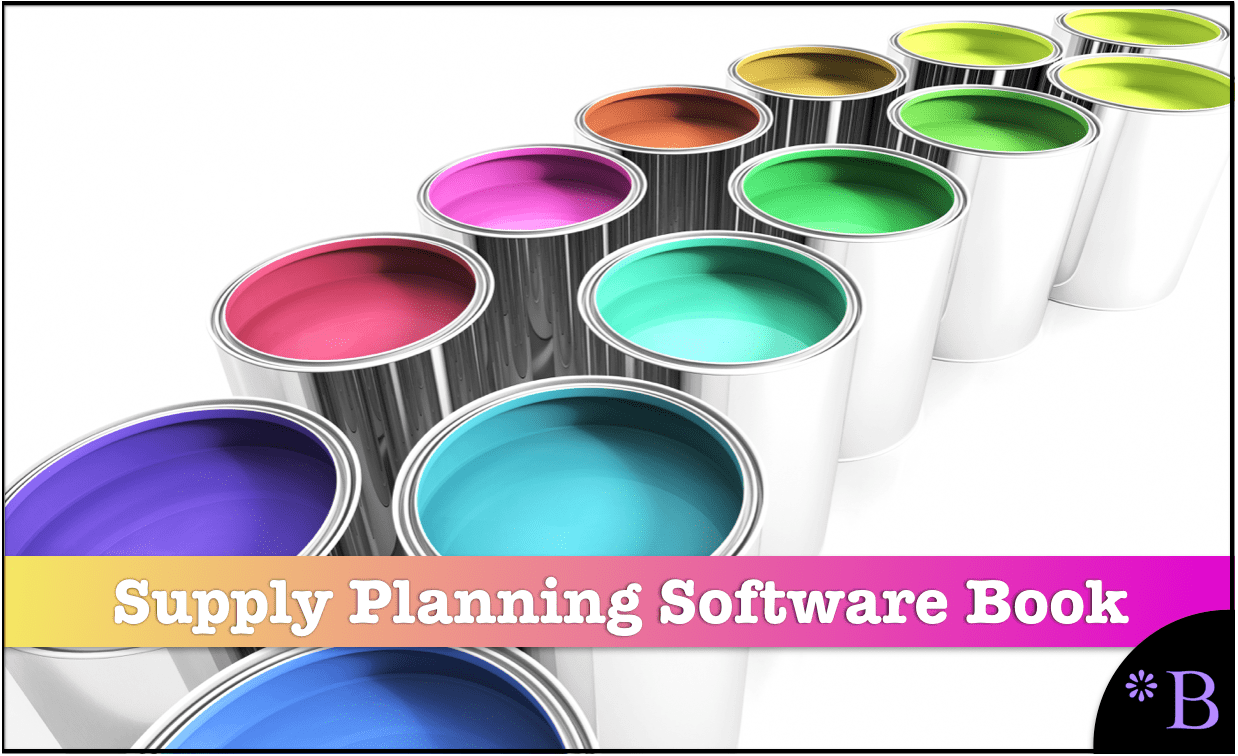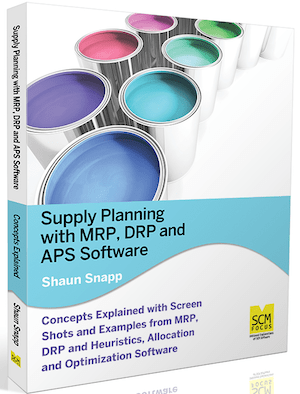
Supply Planning with MRP, DRP and APS Software
Screenshots and examples from JDA, SAP, Demand Works and Barloworld, PlanetTogether, and MATLAB (PlanetTogether is not a supply planning system, but is used in the book to demonstrate heuristic adjusted optimization. MATLAB is used to illustrate the use of an external optimizer.)
Reviews
“Enterprise software solutions for materials requirement planning (MRP), distribution requirement planning (DRP), and advanced planning and scheduling (APS) can be powerful tools— if you know how to use them. This book explains five different supply planning methods and how they are incorporated into various supply planning applications. It also covers constraint-based and reorders point planning, backward and forward consumption, scheduling, and simulation.
Key Takeaways: Supply chain managers will learn how to choose the right supply planning method for their operations, avoid common supply planning software implementation issues, and configure software solutions for maximum effectiveness.” – Inbound Logistics Magazine
What The Book Covers
This book’s focuses on the five non-MIEO methods of supply planning, MRP/DRP, heuristics, allocation, and cost optimization. (MEIO is covered in the companion book). It is written by and targeted at practitioners, and the book explains explicitly how each of the methods works. It also delineates the differences between them, as well as providing the history of their development. As well as what approaches have been found to work in implementing each method over time.
Buy Now
Related Topics to MRP, DRP, Heuristics, Allocation, and Optimization
The book also covers areas such as the bill of material management and master data management that are necessary to implement any supply planning system properly. It is the only supply planning book currently available, which provides a comparative analysis of supply planning concepts with different applications. This includes many screenshots and descriptions of how the screens are configured and used. This provides the reader with some of the most exciting areas of functionality within a variety of applications.
Areas of Focus
- How each of the supply planning methods work.
- How each supply planning method processes the supply network and what that means for the planning output.
- How the MRP and DRP differ with a walkthrough of the bill of material table from a software vendor.
- Planning dependent demand products.
- How to prevent the all too common marginalization of the business on complex supply planning application implementations.
- Lessons on simulation. The pros and cons of performing simulation in the primary planning environment versus an external application.
- How Lean can be incorporated into supply planning applications?
- How to reorder point planning, and how to reorder point planning applies in certain circumstances, even when the most advanced planning methods are available to the company.
- Understanding and explaining the results from a supply planning cost optimizer, and how to correctly measure the quality of output from a supply planning cost optimizer.
- Issues with defining the customer priority list in allocation.
- How constraint-based planning works.
- How to set up, manage, and monitor simulations correctly.
- How lead times are managed in different supply planning applications?
- Redeployment, and why it is so important, even for finished goods companies.
A Book Based in Reality
The book also provides many examples from real-life project experiences, the emphasis being on using this information to improve the future of supply planning projects.
Interconnected to Web Information
In order the keep the book at a manageable and easily readable length, the book also provides numerous links out to the Brightwork Research & Analysis site, where supporting articles allow readers to get into more detail on topics that interest them.
Chapters
- Chapter 1: Introduction
- Chapter 2: Where Supply Planning Fits within the Supply Chain Planning Footprint
- Chapter 3: MRP Explained
- Chapter 4: DRP Explained
- Chapter 5: APS Supply Planning Methods Explained
- Chapter 6: APS for Deployment
- Chapter 7: Constraint-based Planning
- Chapter 8: Reorder Point Planning
- Chapter 9: Planning Parameters
- Chapter 10: How MRP, DRP, and APS Relate to One Another
- Chapter 11: Supply Planning Visibility and Master Data Management
- Chapter 12: Understanding the Difference Between Production versus Simulation Systems
- Chapter 13: Conclusion
Table of Contents
Chapter 1: Introduction
- Background and Motivation
- The Importance of Software Screenshots and Vendor Diversity
- How Writing Bias is controlled at Brightwork Research & Analysis an Brightwork Research & Analysis Press
- Making the Perfect Book for Those Hungry for Precise Information on Supply Planning Software
- The Brightwork Research & Analysis Site
- The History of Supply Planning Software
- Who Is This Book For?
- Abbreviations
Chapter 2: Where Supply Planning Fits within the Supply Chain Planning Footprint
- Introduction
- The Basic Nature of the Supply Chain Planning Functionality in ERP Systems
- How ERP and APS Share the Planning Work
- Critical versus Non-critical Materials
- Dependent Demand Products
- Alternative Design
- Where a Product Location Combination is “Planned”
- Conclusion
Chapter 3: MRP Explained
- Introduction
- A Brief History of MRP
- What MRP Includes
- What MRP Does Not Include
- Major Functionality of MRP
- Manufacturing Capacity Leveling/Planning
- Backward and Forward Scheduling
- The Bill of Material in MRP
- Understanding MRP’s Limitations
- MRP for Multi-plant Transfer
- Cross-location Visibility with MRP?
- MRP’s Impact on Purchasing and Manufacturing
- The Master Production Schedule
- Performing the MPS in APS Systems
- The Importance of the Planning Time Horizon
- Conclusion
Chapter 4: DRP Explained
- Background
- DRP for Deployment
- DRP Examples
- A Simple Way of Understanding DRP
- Location Links in DRP
- Conclusion
Chapter 5: APS Supply Planning Methods
- Background
- The Three Methods within APS
- Heuristics
- What Is a Heuristic?
- Can Heuristics Be Used to Emulate MRP?
- How Heuristics Process the Supply Network
- How Cost Optimization Processes the Supply Network
- How to Think of Heuristics When Selecting Between the Different Supply Planning Methods
- Beyond the Business Requirements
- When Does Using Supply Planning Heuristics Make Sense?
- Allocation
- The SAP APO CTM Application
- CTM Product Substitution
- Defining the Customer Priority List
- Learning From Past Allocation Projects
- How Allocation Decomposes the Network
- How to Think of Implementing Allocation Projects
- When Does Using Allocation Make Sense?
- Cost Optimization
- The Use of the Term “Optimization”
- Linear and Nonlinear Optimization
- Discrete versus Continuous Constraints
- The Combination of Linear and Nonlinear with Continuous and Discrete Constraints
- Supply Planning as Network Flow Problems
- How Supply Planning Cost Optimizers Work
- The Distinction between Implicit versus Explicit Costs
- The Supply Network Problem Segmentation: Decomposition and the Sub-problem
- Sub-problem and Processing Time Allocation at Runtime
- The Measurement of Optimization Solution Quality and the Sub-problem
- The Percent Optimally Solved
- The Meaning of the Terms Optimal and Feasible
- The Usefulness of the Optimal versus Feasible Metric
- Effectively Transitioning a Company between Supply Planning Methods
- Getting Costs into the Optimizer Application
- Understanding Relative Costs concerning Cost Optimization
- A Methodology for Helping the Business Make Value Judgments for the Optimizer
- Cost Optimization Configuration
- Single-objective versus Multi-objective Optimization
- Finding Its Way into Supply Chain Planning
- The Potential of MOO for Supply Planning
- Things to Consider with MOO
- MOO in the Future?
- When Does Cost Optimization Make Sense?
- Lessons of the History of Optimization Projects
- Finding the Right Optimization Implementation Partner
- Keeping the Implementation from Being Purely a Technical Exercise
- Preventing the Marginalization of the Business
- Focusing on Knowledge Transfer
- Being Conscientious of the Costs Entered into the Optimizer
- Mitigating the Issues with Cost Optimization Projects
- Explaining How Costs Work in the Model
- Tracking and Explaining the Optimizer Results
- Increasing Knowledge Sharing and Transparency with a Content Solution
- Triangulate Cost Optimizer Behavior with an External Optimizer
- Make the Optimizer More Approachable
- Getting the Right Implementation Help
- Staffing Support Correctly
- Enterprise Optimizers versus General Solvers
- Preparing the Company for the Complexities of Cost Optimization
- Conclusion
Chapter 6: APS for Deployment
- Background
- Understanding DRP as Just One Method of Deployment
- Deployment Heuristic
- Push versus Pull Deployment
- Fair Share Rules
- How to Set Up the Fair Share Scenarios
- Cost Optimization for Deployment
- Cost Optimization Deployment
- Deployment with Constraints
- Deployment and Redeployment
- Allocation for Deployment
- Conclusion
Chapter 7: Constraint-based Planning
- Background
- The Types of Constraints Commonly Used by Supply Planning Systems
- How Supply Planning Resources Differ from Production Planning Resources
- Essential Considerations for Constraint-Based Systems
- Production Batch Sizes versus Full Resource Constraints
- Constraint-Based Planning in the Application
- Continuous versus Discrete Optimization
- The Challenges of Constraint-based Planning
- Conclusion
Chapter 8: Reorder Point Planning
- Background
- Lean and Reorder Point Planning
- When to Use Reorder Point Planning
- Reorder Point Planning and Make-to-Order Environments
- Quotations on Reorder Point Planning
- Reorder Point Planning for Deployment / Outbound Supply Planning
- Conclusion
Chapter 9: Planning Parameters
- Planning Parameter Maintenance
- Conclusion
Chapter 10: How MRP, DRP, and APS Relate to One Another
- The History of the Supply Planning Methods
- The Origins of the Different Supply Planning Methods
- When Companies Expanded Beyond MRP and DRP
- The Movement towards More Advanced Methods
- Single vs. Multi-Level Bills of Materials (BOMs)
- Understanding the Logic of the MRP and DRP Bill of Materials
- The MRP and DRP Spreadsheets
- The MRP Bill of Material Model
- Variability in BOM Design
- DRP BOM Model
- The Complexity versus the Maintainability of the BOM
- How Is BOM Management Software Different?
- Functionality Often Missing from MRP, DRP, and APS Applications
- Stocking/Destocking
- Redeployment
- Service Level-based Planning
- Conclusion
Chapter 11: Supply Planning Visibility and Master Data Management
- Background
- System Visibility in Supply Planning Systems
- Effective Parameter Management
- How Different Applications Approach Lead-time Setup and Maintenance
- Leads Times in SAP SPP
- Lead Times and SAP SNP
- Conclusion
Chapter 12: Understanding the Difference Between Production versus Simulation
- Equal Simulation Capabilities?
- Aggregation Considerations
- Conclusion
Chapter 13: Conclusion
- Introduction
- The Importance of History to Decision Making
- The Importance of Full Understanding
- Simulation
- Combining the Methods
- The Practice of Supply Planning
- The Future

Buy Now
Questions about the Book?
Do you have any questions about the book? If so, please leave us a comment in the message box to the right, and we will address them.